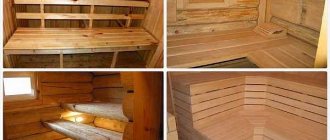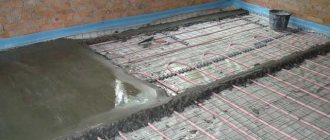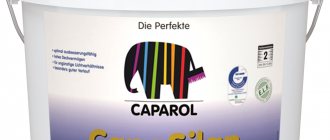Optimal humidity levels in a home may vary depending on the time of year and region of residence. But they must be observed without fail, otherwise health problems cannot be avoided.
Lack of moisture has a detrimental effect on all living organisms, including plants. And increased rates contribute to the spread of fungal infections in the room.
By the way, if you don’t know where and how to install a humidifier correctly, then here is a useful article on this topic.
What is air humidity
In molecular physics, air humidity refers to the content of water vapor molecules in the air around a person. One hundred percent humidity is characterized by the appearance of condensation on surfaces. There is precipitation outside at these levels.
Normal humidity in a living space is usually different from that outside. In an apartment it is more stable, while in the environment it changes under the influence of changing seasons - in autumn and spring it is higher, in winter when there is frost and in summer when it is very hot it is lower.
Fluctuations in humidity are caused by temperature. When it is too high, water molecules evaporate, and when it is very low, they crystallize. In a living room, air is most often made dry by central heating radiators.
Humidity level in your home office or workplace
Performance directly depends on the feeling of vigor. When the moisture level is less than 30%, discomfort, drowsiness, lethargy, and pain in the eyes are felt. Plus, computer technology dries the air even more and saturates it with static electricity. Installing a small-sized humidifier solves this problem. If it has a built-in aroma lamp function, then a couple of drops of orange oil will invigorate you even better.
Excessive moisture in the office is a rare occurrence, but it entails many unpleasant consequences: damp documentation, constant lack of air and a musty smell. Ventilate the room, turn on the air conditioner or portable electric dryer.
What does deviation from the norm lead to?
If the average room humidity is significantly higher than normal (more than 20–30%), various problems may arise:
- The appearance of mold. A humid and warm environment is the optimal condition for the development of fungal spores. Mold most often forms in the bathroom, kitchen, and corners of rooms. In children and people with weakened immune systems, it can cause respiratory problems and allergic reactions. For asthmatics, damp rooms are dangerous because prolonged exposure to them provokes frequent attacks.
- Increased heat transfer. In hot summer weather, high temperatures are felt worse when there is an increased content of moisture particles in the air. The result may be overheating or heatstroke.
Dependence of the development of diseases and fungi on the humidity in the apartment
It is the state of health of the residents of the room that determines what humidity should be in the house. Too high is not suitable for asthmatics, allergy sufferers, small children, people with hypertension, cardiovascular diseases and immunodeficiency.
If the humidity level in a room for a person is not met and the air is too dry, this is also harmful to health:
- Dry mucous membranes. This can manifest as itching and irritation of the eyes, especially in people with contact lenses, a sore throat, and a hacking cough.
- Difficulty breathing. When the mucous membranes of the nasopharynx dry out, they do not perform their protective functions. A person becomes susceptible to colds and infections, nosebleeds, chronic rhinitis, and exacerbation of bronchial asthma.
- Deterioration of skin condition. Peeling, irritation, redness, the appearance of wrinkles - all this occurs against the background of a violation of the hydrobalance of the skin. High air humidity has a particularly bad effect on people with psoriasis, atopic dermatitis and other dermatological diseases.
Most unpleasant symptoms do not appear immediately. But if there is no normal humidity in the apartment, sooner or later its residents will begin to experience discomfort.
The norm of air humidity in the apartment
Recommended GOST 30494-96 air humidity in the room depending on the time of year:
- in winter – 30–45%;
- in the autumn-spring period - 30–45%;
- in summer – 30–60%.
Optimal indoor humidity for people of different ages:
- for adults – from 40 to 60%;
- for children under 6 years old – 50–60%.
The ideal air humidity in an apartment for a person varies depending on the purpose of the room:
- in the bathroom, where the ceiling, walls and floor are usually resistant to water, humidity can reach 60–70%;
- normal humidity in rooms reserved for the kitchen, corridors, pantries is 40–60%;
- in rooms where there are plants, the humidity should not be lower than 60–70%, for tropical and subtropical flowers – up to 80–95%, so it is recommended to take them out onto the balcony, loggia or give them a separate room;
- It makes no sense to regulate humidity on a loggia or balcony, since this is a non-residential premises.
According to SanPiN 2.1.2.2645-10, the relative humidity for premises is placed within a more rigid framework and has values of 60% in the cold season, and 65% in the summer. Some rooms are not standardized due to non-constant or short stay in them, as well as frequent and long-term changes in humidity in these rooms
| The name of a room | Air temperature, °C | Relative humidity, % |
| winter | ||
| Living room | 18–24 | 60 |
| Room in the coldest five-day areas (minus 31 °C and below) | 20–24 | 60 |
| Kitchen | 18–26 | N/N* |
| Toilet | 18–26 | N/N |
| Bathroom, shared bathroom. node | 18–26 | N/N |
| Lobby | 14–20 | N/N |
| Storerooms | 12–22 | N/N |
| summer | ||
| Living room | 20–28 | 65 |
* - not standardized
To increase the service life of household appliances, the safety of books, paintings, and upholstery of upholstered furniture, the humidity level should not exceed 60–65%.
Consequences of dampness in housing
When dampness accumulates in a room, it becomes difficult to breathe. There is a constant feeling of lack of oxygen. Molds and pathogenic microorganisms begin to multiply, which is fraught with the following problems:
- Diseases of the upper respiratory tract are becoming more frequent. They acquire a chronic course: rhinitis, bronchitis, laryngotracheitis, asthma, allergies.
- Presence of foreign moldy odor.
- Things in the closets are always musty.
- Moldy areas appear on the ceiling and walls.
Abnormal humidity levels also affect:
- pets;
- decorative flowers;
- furniture;
- parquet, laminate;
- wood and paper products: books, paintings, window frames.
Normal air humidity in a child's room
The optimal air humidity for a child in an apartment is determined based on his age. Compliance with this parameter is especially important for newborns:
- Features of thermoregulation in infants. The drier the air (which the child inhales), the more fluid the body will spend to hydrate it. This is associated with large losses of water - dryness of the mucous membrane of the nasopharynx and nasal cavity occurs, and it is difficult for the baby to breathe. As a result, he wakes up more often at night, eats poorly, and is capricious.
- Long heating season. In most Russian cities it lasts at least 6 months a year. Central heating radiators can reduce the initial humidity levels in a room by 20–40% or more. Low humidity during the heating season leads to frequent respiratory diseases, chronic rhinitis, and an increased risk of bronchial asthma.
Optimal humidity in a child's room is especially important.
Depending on the age of the child, it is determined what humidity should be in the bedroom. For children in the first year of life, the optimal parameter is 50–70%, for children from 1 to 3 years old – 45–65%, for children over 3 years old almost adult norms are suitable – 50–60%.
How to measure humidity
Relative humidity in the room is measured using special devices - hygrometers. They have different designs and operating principles:
- Electronic. Usually combined with thermometers to simultaneously measure room temperature. In them, a thin layer of electrolyte is applied to the inner plate, through which voltage passes. The results are displayed on the indicator panel.
- Mechanical. Cheaper and easier-to-use instruments, however, can produce measurement errors of up to 8%. They operate without a power source and are available as tabletop or wall-mounted. They do not have a digital display, but are equipped with a dial and arrow.
Electronic hygrometers have good accuracy and are affordable.
There are many ways to determine the saturation of air with moisture, not all of them are popular, but there are:
- Weighted or absolute. It is a device that determines relative humidity by absorbing it. Using special tubes with a chemical composition, he takes measurements. Do not use in domestic conditions.
- Hair. This type of hygrometer is used only in laboratories, and only because its operating principle is based on the study of human hair.
- Film. Also belongs to the category of laboratory instruments. The main mechanism is a special film, which, depending on the level of humidity, stretches or, conversely, contracts. It is most effective to use it in the winter season.
- Electronic. This type of device is most often purchased for household humidity measurements. It is quite simple to use, since the mechanism immediately displays the final measurement result on the touch screen.
- Psychometric. The most accurate type of moisture meter. Often it is purchased for work in production and laboratory premises. Also, many “civilian” users choose psychometric hygrometers because of their comparatively low cost and extreme accuracy.
To determine the standard air humidity in an apartment, an inexpensive mechanical hygrometer is suitable. For domestic use, certification by the metrological service is not required.
It is important to pay attention to the temperature range of use - the maximum value is 80–120 degrees. When used in a sauna or bathhouse, you must choose the extreme option.
Determining humidity without instruments
You can independently find out quite accurately the air humidity in the room without having any instruments. There are two options for this.
When measuring using the first method, you need to measure the air temperature in the room with a thermometer and record the readings. Then take a small piece of cloth or bandage, wet it and wrap the tip of the thermometer and leave it for about 5 minutes. Next, having calculated the difference in readings (subtract the smaller from the larger), you need to use a psychrometric table.
Psychometric table for determining relative air humidity
In the second case, you need to pour a glass of water and cool it in the refrigerator to +3...+5°C. After this, move the glass to a room away from heating devices and leave for 10 minutes. We look at the glass if:
- The glass is dry. The humidity in the room is insufficient.
- There is condensation on the walls. The humidity is fine.
- Large condensation and drips. The humidity is too high.
Increased condensation on a glass with drips indicates increased humidity
User experience in choosing hardware
In general, gritting my teeth, I forked out money for an overseas humidifier. What should we do if we haven’t developed ours in Tion yet... Here are a few words about how I chose it. Since we started digging into this topic, with the help of our engineers I got a little more familiar with the technology. Therefore, I immediately disgustedly refused ultrasound - consider it my problem, but I don’t want to breathe everything that is found in tap water, all sorts of salts and other evil spirits. All the declared softeners and super-nano rods cannot remove all this slag, but pouring in five liters of distillate a day - excuse me, look for it yourself). We don’t have a stationary reverse osmosis filter... I don’t want a “boiler” either, it will eat electricity like a horse. So I was immediately in favor of natural humidification, that is, everything that is included in “surface” (adiabatic) humidifiers or “air washers.” Well, I love everything natural, what can I do). There, just a cloth or disk constantly gets wet, but at the same time it rotates and is blown by a fan. There are, of course, disadvantages - the higher the relative humidity, the worse the process, but this correlates with our needs for moisture - the more humid it is, the less air “sucks out” water from us, like a sponge. Well, according to calculations, for one room in winter, with normal ventilation, the power needed is about 500 g/hour. Then I dug through the reviews/specifications a little and ordered it. I’ll make a reservation right away that I won’t indicate the brand, it would cost the manufacturer too much).
How to increase air humidity with household appliances
The most affordable and popular device for increasing humidity in the air is a household humidifier. It can be used all year round, but it will be especially useful in winter, when indoor humidity of 20 percent causes discomfort.
The following types of humidifiers are available:
- Classic. The operating principle of such devices is based on the evaporation of cold water without preheating. Water flows from a special container onto the evaporator - disk, filter or cartridge. Due to the fact that such devices take air from the room and release it after cleaning with a filter, additional removal of dust and allergens occurs.
- Humidifiers with air purification function. These are full-fledged climate control devices that simultaneously increase the level of humidity and purify the air by equipping them with special replaceable filters. They are also called air washers.
- Steam models. The operating principle of such devices is similar to the operation of an electric kettle. Heating elements with a ceramic plate or coil release steam after preheating the water. It is optimal to use both in summer and to maintain humidity levels in the apartment in winter.
- Ultrasonic. The most expensive and effective. The liquid poured into the reservoir flows onto a plate that vibrates under the influence of ultrasound. The water breaks up into tiny droplets, which enter the room through a cooler inside the case.
Air humidifier with cleaning function (air washing)
Steam humidifier
Ultrasonic humidifier
With the help of such devices you can not only create comfortable humidity in the apartment, but also regulate other parameters:
- control temperature;
- neutralize pathogenic microbes;
- trap dust and allergens.
The action of a humidifier can cover different areas, which must be taken into account when purchasing. Small household appliances are suitable for the bedroom or kitchen. For a living room or other larger rooms, you need a powerful device.
Installation of humidity control sensors
In order to constantly monitor the level of humidity in the apartment, you should install humidity sensors at home. These are the same hygrometers, but more accurate and modern. Most of them work through certain electronic or mechanical means that respond to changes in the level of the indicator in the apartment.
The most accurate is an optical hygrometer, which is focused on determining the dew point temperature of a gas.
Other humidity sensors are intended primarily for industrial and agricultural use.
These include capacitive, the operating principle of which is built around condensation - the higher the humidity, the larger the capacity. Some climate control systems have built-in hygrometers of varying degrees of accuracy, so in some cases they may be preferred over sensors. The advantage of sensors is their accuracy, autonomy and wide space coverage.
The health of all residents, as well as the condition of household appliances, furniture and any other household items, plants and pets, is affected by air humidity that is comfortable for humans. At the moment, there are many devices that can accurately measure and effectively correct microclimate indicators.
Article design: Vladimir the Great
How to increase air humidity using folk remedies
Air humidity in a dry room can be increased using traditional methods:
- regular wet cleaning;
- frequent ventilation (not in sub-zero temperatures), especially after rain;
- installation of a mini fountain, aquarium or other water containers;
- growing flowers and watering them regularly;
- reducing the intensity of heating radiators using wet towels;
- using a spray bottle.
Folk remedies to increase the humidity in the room
To increase the humidity in the room, you can dry clothes directly indoors, and not on the balcony or street. When cooking food, water vapor from boiling pots also enters the air.
What affects the microclimate
Humidity is a value that depends on the following factors:
- Ventilation - the better the ventilation of the room is organized, the better it maintains a normal level of humidity. Ventilation stabilizes the indicator to a natural level, as it helps remove excess moisture from the room and purify the air.
- Heating means - batteries, radiators, stationary heating means - the warmer the air, the drier it is.
- Means for optimizing the microclimate - air conditioners, humidifiers, climate control and other devices that can humidify the air. This is especially true for air washers, which are equipped with devices for multi-stage air purification. Air conditioners, on the contrary, dry the air due to the fact that excess moisture condenses.
- All household procedures related to water - cleaning, cooking, washing - contribute to air humidification.
- Time of year and outside temperature - the warmer the air, the drier it is. Therefore, the humidity standard in GOSTs has an error for the warm and cold seasons.
- The layout of the apartment, sealing materials (plastic windows, sound insulation, etc.) affect humidity. The more sealed the room, the worse the ventilation in it, and accordingly, the drier the air there.
Air humidity that is comfortable for a person can be arranged in an apartment by knowing the factors that influence the level of air dryness.
How to reduce humidity
High humidity is not always a good thing. If mold, mildew appears on the walls, or condensation constantly collects, it must be reduced. You can use one of these methods:
- Dehumidifiers. Special devices absorb excess water molecules, taking air from the room. The principle of operation of such a device is based on the condensation of steam in the room. The air conditioner performs part of the functions of a dehumidifier - it also takes water from the air.
- Good ventilation. Clogged air ducts do not cope with the function of removing excess wet air from the apartment.
- Drying clothes outside or on the balcony. When drying, the fabrics release water molecules into the air, which circulates throughout all rooms and increases humidity.
- Sunlight. When it enters a room, it causes water to evaporate, so it is recommended to open windows regularly.
Some factors that increase humidity cannot be influenced:
- the more people live in an apartment, the lower this figure will be;
- if all the windows face north, the rooms most often have dampness;
- In some cities, climatic conditions determine constant high humidity.
How to achieve normal humidity if it is too low or high?
If the apartment is too humid, you can reduce the indicator like this:
- check and adjust the operation of the ventilation; if a natural system is in operation, install a forced one (exhaust hood, possibly with a humidity sensor);
- install a dehumidifier;
- install air conditioning, additional heater;
- find and eliminate leaks in pipes;
- do not dry laundry in rooms, bathrooms, kitchens, and hallways;
- ventilate more often.
If it's too dry:
- use heaters and air conditioning less often;
- install a humidifier;
- regularly carry out wet cleaning;
- put indoor plants (you can have flowers on the windowsill, you can have larger plants).
You can read more about too high and too low humidity and measures to eliminate them separately.
How natural ventilation works: a detailed and understandable description
When is ventilation needed on the balcony, and how can it be organized correctly?











